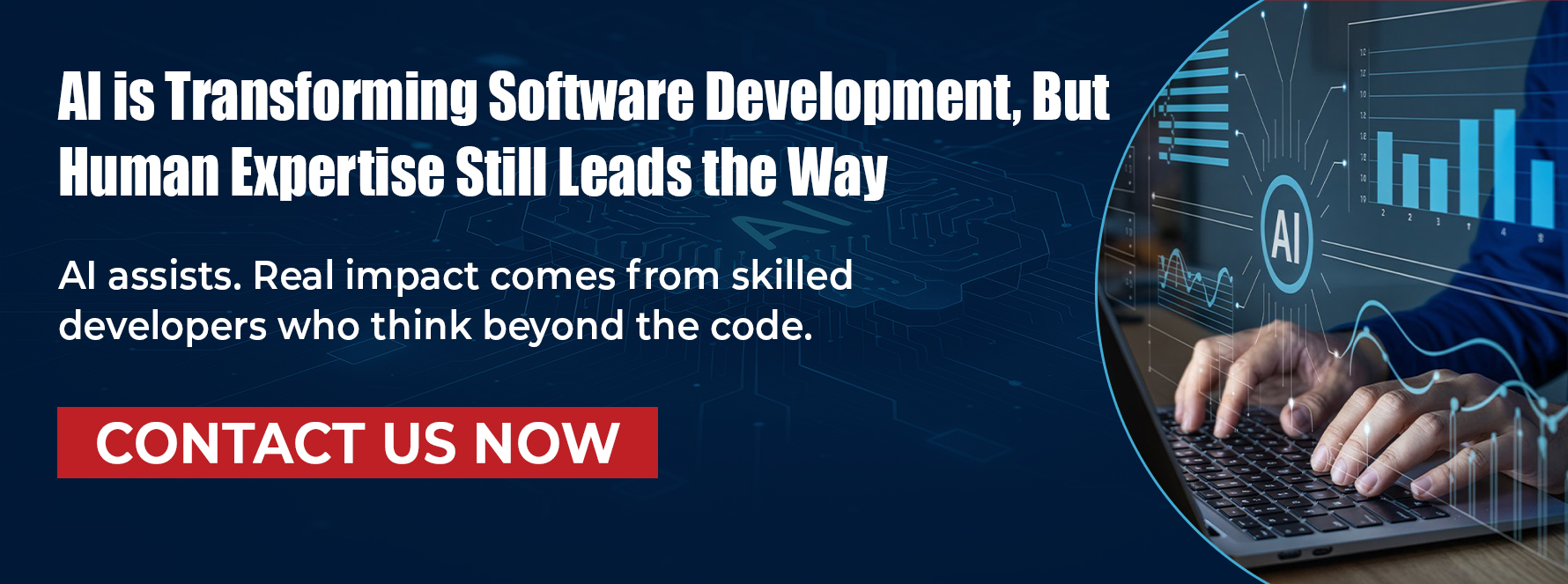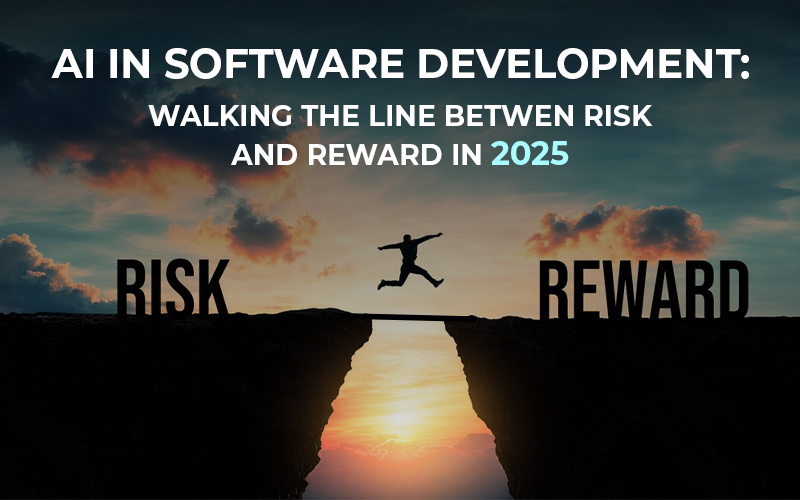The rise of AI artificial intelligence is shaking up the world of web application development, custom solutions, and web development services. But is it a boon, a threat, or both? At Scrum Digital, we explore how AI is transforming web development company workflows in 2025, and how you can embrace the future while mitigating the risks.
1. The AI Explosion: Opportunity Meets Caution
By 2025, developers across custom web development houses are using AI-powered tools for tasks from boilerplate generation to architecture suggestion. Leading firms report 20 – 30% of code now comes from AI assistants like GitHub Copilot or Cursor, which one article calls “coding agents go mainstream”. This makes routine development faster, reduces bugs, and frees human talent for strategic thinking.
Yet automation introduces new risks: AI-generated code can carry biases, security flaws, or poorly documented logic. These tools often act as black boxes unless explainability is embedded, from LIME to SHAP, within the development lifecycle.
So, is AI a risk, an opportunity, or both? The answer depends on how responsibly it’s adopted.
2. Where AI Boosts Web Development – Fast

Accelerated Development & Prototyping
AI in web development speeds prototypes by turning natural language prompts into functional frontend and backend code. With AI website builders or AI template generator systems, teams can spin up MVPs rapidly and iterate visually, democratizing access beyond technical experts.
Smarter Maintenance & Legacy Migration
Tackling outdated codebases becomes simpler: modern AI tools perform legacy analysis, automate refactoring, generate documentation, and help fix technical debt faster than traditional methods. For any web development company working with legacy systems, that’s a game‑changer.
CI/CD, Testing & QA Automation
Gone are the days of manually writing test suites. AI-powered tools now generate test cases from requirements or behavior specs, run simulations, and even flag deployment issues before they happen, fundamentally changing web application development pipelines.
Optimized UX & Conversion Metrics
When integrated with Conversion rate optimization workflows, AI can suggest layout improvements, perform A/B tests, and predict click-through rate trends. That makes Strategic web design smarter, turning data into decisions in real-time.
3. The Risks: Why AI Isn’t a Magic Wand
Bias, Privacy & Ethical Blind Spots
Biases or unsafe practices may be propagated by AI models trained on existing code. Legal and regulatory awareness is rising, from 55% to over 72% compliance in 2025, but many teams still lack structured oversight. Deploying AI without deep transparency or auditability leads to systemic issues.
Security Vulnerabilities from Auto‑Generated Code
AI doesn’t always follow security best practices. Auto-generated routines may omit proper authentication or input validation, increasing risk if not reviewed carefully.
Job Shifts & Developer Skill Gaps
While AI in software development boosts productivity, it also shifts what skills are valuable. Routine coding roles may shrink as AI takes over, especially in template-heavy workflows, leading to reduced demand for junior devs and higher expectations for strategic, architecture‑level thinking.
Technical Debt & Unintended Complexity
Generated code may meet immediate needs but create hidden complexity later. This could compromise long-term maintainability or make the design intent less clear. Without thoughtful oversight, artificial intelligence becomes a shortcut to fragility, not efficiency.
4. Emerging Trends Shaping the Future of Web Development

The Agentic Web & AGI Potential
The concept of an agentic web, autonomous agents capable of making decisions on a user’s behalf, is accelerating the development of AGI (Artificial General Intelligence)-style behaviors online. For Strategic web design and web development services, that means building apps that interact with users intelligently, without constant developer intervention.
Vibe Coding & Creative Flow Development
A new paradigm – “vibe coding” – pairs developers in creative collaboration with LLMs to iterate conversationally on code, instead of micromanaging via prompts. This makes custom web development feel more intuitive and exploratory, but also demands strong oversight to keep things secure and coherent.
Explainable AI for Credibility
Growing research in XAI technologies aims to make AI model decisions more understandable across the Software Development Lifecycle, from design to deployment. For regulated industries or enterprise clients, this is a must-have.
5. Is AI a Risk, Opportunity, or Both?
| Dimension | Opportunity | Risk | Balanced View |
|---|---|---|---|
| Development Speed | Faster prototyping, automated code, improved efficiency | Generated code errors, hidden bugs | Use AI tools with expert review and guardrails |
| Cost & Budget | Lower dev spend, higher throughput | Overreliance may reduce staffing or strategic oversight | Balance automation with strong leadership |
| Quality & Maintenance | Automated tests, legacy refactoring, and documentation | Accumulated technical debt, lack of coherence | Regular audits and human-guided refactors |
| Workforce & Roles | Higher-level roles, strategic thinking, and an architectural focus | Entry-level jobs decline, skill mismatch | Invest in training, evolving job descriptions |
| Ethics & Regulation | Explainable models, better governance | Biased or opaque AI decisions, regulatory non-compliance | Embed compliance & XAI in every AI-powered workflow |
6. Best Practices for AI in Web-Based Software Projects

- Integrate AI thoughtfully – Use AI template generators and AI website builders as powerful accelerators for repetitive tasks and layout scaffolding, but never as one-size-fits-all solutions. Human oversight ensures these tools align with brand voice, technical standards, and user needs. Blend automation with creativity, not in place of it.
- Maintain human control – Treat AI like a trusted assistant, not an autonomous creator. While AI can produce code, design concepts, or even content drafts, final decisions around UX, performance, and security should remain firmly in the hands of experienced developers and designers. Human judgment ensures quality and context.
- Invest in transparency – Implement XAI (Explainable AI) frameworks to ensure decisions made by AI models are understandable, traceable, and auditable. Establish regular code audits, documentation checkpoints, and compliance reviews to avoid black-box behavior and protect stakeholder trust, especially in regulated industries.
- Upskill your team – AI shifts the developer’s role from executor to strategist. Developers must build skills in system architecture, AI integration, prompt engineering, and ethical analysis. Continuous training ensures your team can manage evolving tools effectively and create solutions that are both innovative and responsible.
- Monitor performance metrics – Track how AI-influenced design or functionality impacts key metrics like click-through rate and conversion rate optimization. Real-time analytics, A/B testing, and user feedback loops can help fine-tune AI contributions and prove ROI, turning insights into iterative improvements.
7. What the Industry Thinks
Developers surveyed by Reddit and industry forums describe AI tools as “just another tool in the toolbox.” Many believe AI amplifies productivity, but only when wielded by skilled engineers who understand where it works well and where it doesn’t. At the same time, CTOs confirm that AI is reshaping roles but not eliminating them; developers who adapt will thrive; those who rely blindly may struggle.
Another analysis from tech publications highlights that by late 2025, AI will be writing up to 45% of new code in large firms, accelerating DevOps pipelines while requiring new oversight mechanisms.
8. How Scrum Digital Embraces This Future

At Scrum Digital, we leverage carefully chosen AI-powered tools and advanced AI artificial intelligence techniques to supercharge web application development and deliver results-driven web development services. Whether you’re looking for a web development company to craft custom solutions or a long-term partner for strategic web design, our approach blends innovation with accountability.
- AI-augmented prototyping: Rapid proof-of-concept creation using natural language prompts, with iterative improvements driven by expert feedback.
- Secure architecture planning: AI models system performance and scalability while our architects ensure long-term maintainability, compliance, and security.
- Conversion-focused implementation: Websites are engineered not just to look good, but to maximize click-through rate and boost conversion rate optimization using AI insights.
- Ethical and transparent delivery: We embed explainable AI (XAI), data privacy standards, and detailed audit trails to ensure responsible AI integration at every step.
Our teams continuously train in the latest AI innovations to deliver cutting-edge, scalable solutions that future-proof your business. With Scrum Digital, you’re not just building a website; you’re investing in the future of web development.
9. Final Thoughts: It’s Both Risk and Opportunity
In 2025, custom web development is transforming. AI brings undeniable opportunity, speed, cost savings, innovation, but also risk: bias, security gaps, and workforce disruption. The key to success lies in a balanced approach: harness AI in web development responsibly, combine machine efficiency with human judgment, and build future-ready systems that scale safely.
Unlock the real potential of AI for your business with Scrum Digital, where web development services blend cutting-edge tech with trusted human expertise.
Further Reading
Curious about how AI is reshaping e‑commerce as well? You can also read our blog: “Can AI‑Powered Platforms Give Your E‑commerce Business a Competitive Edge?”



